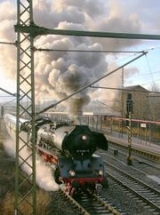
DRG Class 41
Encyclopedia
The German Class 41 steam locomotive
s were standard goods train engines (Einheitslokomotive
n) operated by the Deutsche Reichsbahn (DRB) and built from 1937 - 1941.
(DRG) in 1934 was attracted by the proposal from the Berliner Maschinenbau
(BMAG, formerly Louis Schwartzkopff
) for a 2-8-2
(1'D1'h2) engine. The design, produced by Friedrich Wilhelm Eckhardt
(1892–1961), differed from the DRG's original requirement for a 2-8-0
(1'D) engine, because the required performance with an 18 ton axle load
was easier to generate on a 2-8-2 engine rather than one with a 2-8-0 wheel configuration. Continued adherence to this instruction would in the end have given the new engine no significant advantage over the Prussian goods train locomotives which were to be withdrawn. The Reichsbahn Central Office Engineering Works (RZM) eventually agreed to this proposal; the BMAG was tasked to develop the proposed design and produce two prototypes.
In January 1937 the two prototype locomotives, 41 001 and 41 002, were delivered to the DRG, who subsequently tested them thoroughly and bought them. The prototypes soon proved themselves, with their power, performance and quiet riding qualities, as well as their exceptional acceleration.
In developing the Class 41, the principle of having standard locomotives (Einheitslok
s) demonstrated the financial advantages of standardization. For example, the construction costs of the engine, through the use of components from the simultaneously developed Class 03
, 06 and 45
engines, was under 10,000 Reichsmarks.
From October 1938, the first full-scale production Class 41 locomotives were ordered by the now renamed (since February 1937) Deutsche Reichsbahn
(DRB). All the well-known locomotive manufacturers in Germany participated in the building of the locomotives, including BMAG
, Borsig, Maschinenfabrik Esslingen
, Henschel & Sohn, Arnold Jung Lokomotivfabrik
, Krauss-Maffei
, Krupp
, Orenstein & Koppel and Schichau
.
Unlike the prototype locomotives, corner valve pressure compensators were omitted from the production locos and Nicolai pressure compensating tubular valves (later Karl Schultz valves) were used to give a better ride when running light. On the valve gear
, the normal lifting link (Hängeeisen) replaced the Kuhn slide
s of the prototypes which were expensive to manufacture.
As with Classes 03, 45 and 50, the 20-bar boiler, which was made of St 47 K and not a non-aging steel, soon caused major problems. As early as 1941, the DRB decreed a reduction of the permissible operating pressure to 16 bar. In this way the wear and tear on the boiler could at least be slowed down.
The axle load
of the locomotive could be switched between 18 t and 20 t by inserting bolts into different sockets in the compensating levers. This was supposed to enable the locomotive to be more versatile in its use. Little or no use was made of this flexibility however. The Deutsche Bundesbahn
and East German DR later left the bolts in the 18 t setting.
The locomotives were, with the exception of the prototypes, coupled to 2'2'T34 tender
s. The prototypes, 41 001 and 41 002, had 2'2'T32 tenders on delivery. From their use of 20m turntable
s, it is also known that some engines were running with 2'2T30 tenders.
The advent of war increasingly stifled the purchase of fast goods train locomotives until, in January 1941, the existing orders were cancelled completely. On 2 June 1941, MF Esslingen delivered the last Class 41 locomotive, no. 41 352, to the DRB. With that a total of 366 engines of this class had been built in just under four years.
fleet and 122 were left in the hands of the DR in East Germany. There is evidence that, in addition, 22 locomotives were left in the former Reichsbahn railway division of Breslau in Poland
and later incorporated into the Polish State Railways
(PKP) as Ot 1-1 to Ot 1-19. Number 41 153 was listed on the books of the Czechoslovakian State Railways
(CSD) after 1945. Number 41 034 as well as other locomotives (41 076, 41 082 and 41 312) from locomotive convoys (reparations
) were left in the territory of the Soviet State Railway (SZD) and later transferred to the PKP. The fate of other locomotives is unknown.
As a result of the employment of the two prototype locomotives at Schneidemühl (present-day Piła) locomotive shed in heading express cattle trains to Berlin, the engines were unflatteringly christened Ochsenlok (Oxen loco).
. In addition the front part of the frame
and the running plate were changed. Forty examples were converted to oil-firing with heavy oil. From 1968, these were designated as Class 042. The last Class 042 steam locomotives were retired in 1977 at Rheine
locomotive shed. The photograph (right) shows one as a museum loco, now reclassified to Class 41 (the pre-1968 designation).
The former DB locomotives, 41 105 and 41 241, have been preserved as representatives of their class by Stoom Stichting Nederland
in the Netherlands
. Number 41 018, an operational loco owned by the Munich Steam Locomotive Company
, is stabled at the Augsburg Railway Park
and 41 113 is exhibited in the Technical Museum at Sinsheim
. The Osnabrück Steam Engine Friends are working hard to restore 41 052 to operational status, after it had stood for a long time as a monument at Osnabrück
-Schinkel. Number 41 360 is operated by the Dampflok-Tradition Oberhausen e.V. Since the end of ban on steam locomotives, she has provided a comprehensive programme of journeys on the Deutsche Bahn
's railway network.
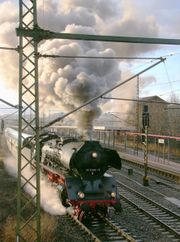 The DR too had difficulties with boiler
The DR too had difficulties with boiler
s made of St 47 K steel. The reduction of boiler overpressure
from 20 to 16 bar had certainly slowed down their susceptibility to damage, but could not prevent it entirely. Of the 112 locomotives recorded in the DR fleet in 1955, only 12 had already been equipped with a '1943 Type' replacement boiler and were therefore safe. Problems with the St 47 K boilers, however, increased massively. Repair welding did not produce the desired effect, but made the material even more brittle and the danger of cracks developing and boiler explosion
s was greater than before. And it was not just the Class 41 that was affected. Classes 03
, 03.10
and 50, with boilers made of non-aging St 47 K, were also prone to damage. As a result of increasing difficulties the DR had to withdraw over 300 locomotives from service in 1956 which abruptly led to an enormous shortage of engines. The urgent call for action which then resulted led at last to the development and subsequent ordering of a new boiler (later called the 39E) that, with a few minor alterations, was also usable on locomotive classe 03, 03.10 and 39.
Because the delivery of the new boilers kept being delayed, 21 Class 41 locomotives were simply fitted with replacement boilers to the old design by January 1959. Even the Meiningen repair shop
made a complete copy of the old boiler for 41 075. Other damaged boilers were fully repaired and many parts replaced.
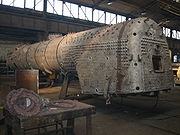 Regardless of that, DR engineers worked on a "reconstruction programme for the recovery of the steam locomotive fleet." This envisaged, amongst other things, the modernisation of 102 Class 41 locomotives. The German term used for reconstruction was Rekonstrucktion or Reko for short, hence the subsequent designation of the locomotives as Rekolokomotiven or Rekoloks.
Regardless of that, DR engineers worked on a "reconstruction programme for the recovery of the steam locomotive fleet." This envisaged, amongst other things, the modernisation of 102 Class 41 locomotives. The German term used for reconstruction was Rekonstrucktion or Reko for short, hence the subsequent designation of the locomotives as Rekolokomotiven or Rekoloks.
Demarcation disputes, disagreements over the detail of the reconstruction programme and the continued non-delivery of the Reko boiler, delayed the start of work still further. Only the explosion of 03 1046's St47K boiler in 1958 at Wünsdorf led to pressure from the then transport minister, Erwin Kramer (1902–1979), to get started on the Reko programme.
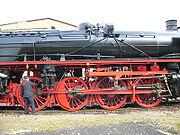
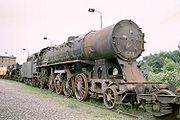
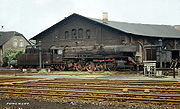 From 1959 onwards, 80 Class 41 locomotives were to be given the new 39E Reko boilers in the Zwickau
From 1959 onwards, 80 Class 41 locomotives were to be given the new 39E Reko boilers in the Zwickau
and Karl Marx Stadt
Reichsbahn repair shops (Reichsbahnausbesserungswerke or RAW).
As part of the rebuild, IfS/DR mixer preheaters, pressure compensating tubular valves (Trofimoff valves) and new Stühren ash pans were installed. The wider outer firebox needed new front walls to the driver's cab, the front windows of which were equipped with demisting equipment. For the larger and heavier VMP 15-20 compounded mixer pump (Verbundmischpumpe) a new pump mount had to be built. This and the new mixer preheater apparatus required a different arrangement for the main air reservoir. The outside cylinders
with a diameter of just 520 mm (20.5 in), originally designed for boiler pressures of 20 bar, were retained however. In the course of the rebuild, the brakes on the front carrying axle were removed.
The 39E Reko boiler fitted to the engines is a combustion chamber
boiler and can generate 15 tons of steam per hour, thanks to the improved ratio of radiative to tube heating area. This is considerably higher than, for example, the new DB boiler which generates only 13.3 tons of steam per hour. Fitted with this boiler, the engine was able to exceed the performance requirements that it originally had for the 20 bar boilers, in spite of its small cylinders.
The engines rebuilt in this way are classified as Rekolokomotiven. Following their conversion, the DR gave all Class 41 locomotives the extra digit 1 under their 1970 renumbering scheme, so that e.g. number 41 122 became number 41 1122-5. In contrast to other classes, the Class 41 was not given a separate sub-class to distinguish Reko from non-Reko locomotives.
Class 41 Rekoloks could be seen in regular train service until 1988. The second oil crisis in 1979/80, and its effect on the GDR's economy, granted quite a number of Class 41 engines a short return to operational duties. Even several locomotives earmarked for scrapping were refurbished and were given a new general inspection service. The Meiningen repair shed refurbished a total of 23 locomotives of this class between 1980 and 1983. But by the end of September 1984, Oebisfelde
shed withdrew the 41s and transferred its locomotives to Güsten
shed. Göschwitz station, a satellite of Saalfeld shed was the next to send its 41s to the storage sidings in November 1986, and at the beginning of May 1988, Staßfurt
(Bw Güsten
) parted company with the last Class 41 locomotive, 41 1231, in regular service in the DR.
The Class 41 was the most versatile steam locomotive in the DR's engine fleet and hauled high-profile express and fast trains, as well as goods and passenger services.
Number 41 1185 was a DR heritage locomotive, now in the ownership of the Nuremberg Transport Museum
.
As of 2009 the following are the only two operational locomotives remaining:
A further 8 Rekolokomotiven are in varying states of repair. See the list of preserved steam locomotives in Germany
Steam locomotive
A steam locomotive is a railway locomotive that produces its power through a steam engine. These locomotives are fueled by burning some combustible material, usually coal, wood or oil, to produce steam in a boiler, which drives the steam engine...
s were standard goods train engines (Einheitslokomotive
Einheitsdampflokomotive
The German term Einheitsdampflokomotive, sometimes shortened to Einheitslokomotive or Einheitslok, means standard steam locomotive and refers to the steam engines built in Germany after 1925 under the direction of the Deutsche Reichsbahn-Gesellschaft...
n) operated by the Deutsche Reichsbahn (DRB) and built from 1937 - 1941.
History
In the search for a new, fast, goods train locomotive, the Deutsche Reichsbahn-GesellschaftDeutsche Reichsbahn-Gesellschaft
The Deutsche Reichsbahn – was the name of the German national railway created from the railways of the individual states of the German Empire following the end of World War I....
(DRG) in 1934 was attracted by the proposal from the Berliner Maschinenbau
Berliner Maschinenbau
Berliner Maschinenbau AG was a German manufacturer of locomotives.The factory was founded by Louis Victor Robert Schwartzkopff on 3 October 1852 as Eisengießerei und Maschinen-Fabrik von L. Schwartzkopff in Berlin ....
(BMAG, formerly Louis Schwartzkopff
Louis Victor Robert Schwartzkopff
- Life :Louis Schwartzkopff was born in Magdeburg. Between 1831 and 1842 he attended the grammar school in Magdeburg as well as the trade school there, where he, together with Carl Wilhelm Siemens, studied mathematics under Carl’s brother, Werner von Siemens. From 1842 to 1845 Schwartzkopff...
) for a 2-8-2
2-8-2
Under the Whyte notation for the classification of steam locomotives, 2-8-2 represents the wheel arrangement of two leading wheels on one axle , eight powered and coupled driving wheels on four axles, and two trailing wheels on one axle...
(1'D1'h2) engine. The design, produced by Friedrich Wilhelm Eckhardt
Friedrich Wilhelm Eckhardt
Friedrich Wilhelm Eckhardt was a German engineer and head of the design office for the Berliner Maschinenbau Aktien Gesellschaft vormals L. Schwartzkopff.- Life :...
(1892–1961), differed from the DRG's original requirement for a 2-8-0
2-8-0
Under the Whyte notation for the classification of steam locomotives, 2-8-0 represents the wheel arrangement of two leading wheels on one axle , eight powered and coupled driving wheels on four axles, and no trailing wheels...
(1'D) engine, because the required performance with an 18 ton axle load
Axle load
The axle load of a wheeled vehicle is the total weight felt by the roadway for all wheels connected to a given axle. Viewed another way, it is the fraction of total vehicle weight resting on a given axle...
was easier to generate on a 2-8-2 engine rather than one with a 2-8-0 wheel configuration. Continued adherence to this instruction would in the end have given the new engine no significant advantage over the Prussian goods train locomotives which were to be withdrawn. The Reichsbahn Central Office Engineering Works (RZM) eventually agreed to this proposal; the BMAG was tasked to develop the proposed design and produce two prototypes.
In January 1937 the two prototype locomotives, 41 001 and 41 002, were delivered to the DRG, who subsequently tested them thoroughly and bought them. The prototypes soon proved themselves, with their power, performance and quiet riding qualities, as well as their exceptional acceleration.
In developing the Class 41, the principle of having standard locomotives (Einheitslok
Einheitsdampflokomotive
The German term Einheitsdampflokomotive, sometimes shortened to Einheitslokomotive or Einheitslok, means standard steam locomotive and refers to the steam engines built in Germany after 1925 under the direction of the Deutsche Reichsbahn-Gesellschaft...
s) demonstrated the financial advantages of standardization. For example, the construction costs of the engine, through the use of components from the simultaneously developed Class 03
DRG Class 03
The Class 03 steam engines were standard express train locomotives in service with the Deutsche Reichsbahn.- History :...
, 06 and 45
DRG Class 45
German Class 45 steam locomotives were standard locomotives designed by the Deutsche Reichsbahn for hauling goods trains.- History :...
engines, was under 10,000 Reichsmarks.
From October 1938, the first full-scale production Class 41 locomotives were ordered by the now renamed (since February 1937) Deutsche Reichsbahn
Deutsche Reichsbahn
Deutsche Reichsbahn was the name of the following two companies:* Deutsche Reichsbahn, the German Imperial Railways during the Weimar Republic, the Third Reich and the immediate aftermath...
(DRB). All the well-known locomotive manufacturers in Germany participated in the building of the locomotives, including BMAG
Berliner Maschinenbau
Berliner Maschinenbau AG was a German manufacturer of locomotives.The factory was founded by Louis Victor Robert Schwartzkopff on 3 October 1852 as Eisengießerei und Maschinen-Fabrik von L. Schwartzkopff in Berlin ....
, Borsig, Maschinenfabrik Esslingen
Maschinenfabrik Esslingen
Maschinenfabrik Esslingen , was a German engineering firm that manufactured locomotives, tramways, railway wagons, roll-blocks, technical equipment for the railways, , bridges, steel structures, pumps and boilers.-Founding:...
, Henschel & Sohn, Arnold Jung Lokomotivfabrik
Arnold Jung Lokomotivfabrik
The Arnold Jung Lokomotivfabrik was a locomotive manufacturer, in particular of Feldbahn locomotives, in Kirchen, Rheinland-Pfalz, Germany....
, Krauss-Maffei
Krauss-Maffei
The Krauss-Maffei Wegmann GmbH & Co KG or simply Krauss-Maffei is an injection molding machine manufacturer and defence company based in Munich, Germany...
, Krupp
Krupp
The Krupp family , a prominent 400-year-old German dynasty from Essen, have become famous for their steel production and for their manufacture of ammunition and armaments. The family business, known as Friedrich Krupp AG Hoesch-Krupp, was the largest company in Europe at the beginning of the 20th...
, Orenstein & Koppel and Schichau
Schichau-Werke
The Schichau-Werke was a German engineering works and shipyard based in Elbing, formerly part of the German Empire, and which is today the town of Elbląg in northern Poland. It also had a subsidiary shipyard in Danzig .-Early years:...
.
Unlike the prototype locomotives, corner valve pressure compensators were omitted from the production locos and Nicolai pressure compensating tubular valves (later Karl Schultz valves) were used to give a better ride when running light. On the valve gear
Valve gear
The valve gear of a steam engine is the mechanism that operates the inlet and exhaust valves to admit steam into the cylinder and allow exhaust steam to escape, respectively, at the correct points in the cycle...
, the normal lifting link (Hängeeisen) replaced the Kuhn slide
Kuhn slide
The Kuhn slide is part of a modified Walschaerts valve gear on steam locomotives and is named after its inventor, Michaal Kuhn...
s of the prototypes which were expensive to manufacture.
As with Classes 03, 45 and 50, the 20-bar boiler, which was made of St 47 K and not a non-aging steel, soon caused major problems. As early as 1941, the DRB decreed a reduction of the permissible operating pressure to 16 bar. In this way the wear and tear on the boiler could at least be slowed down.
The axle load
Axle load
The axle load of a wheeled vehicle is the total weight felt by the roadway for all wheels connected to a given axle. Viewed another way, it is the fraction of total vehicle weight resting on a given axle...
of the locomotive could be switched between 18 t and 20 t by inserting bolts into different sockets in the compensating levers. This was supposed to enable the locomotive to be more versatile in its use. Little or no use was made of this flexibility however. The Deutsche Bundesbahn
Deutsche Bundesbahn
The Deutsche Bundesbahn or DB was formed as the state railway of the newly established Federal Republic of Germany on September 7, 1949 as a successor of the Deutsche Reichsbahn-Gesellschaft '...
and East German DR later left the bolts in the 18 t setting.
The locomotives were, with the exception of the prototypes, coupled to 2'2'T34 tender
Tender locomotive
A tender or coal-car is a special rail vehicle hauled by a steam locomotive containing the locomotive's fuel and water. Steam locomotives consume large quantities of water compared to the quantity of fuel, so tenders are necessary to keep the locomotive running over long distances. A locomotive...
s. The prototypes, 41 001 and 41 002, had 2'2'T32 tenders on delivery. From their use of 20m turntable
Turntable (railroad)
A railway turntable is a device for turning railroad rolling stock. When steam locomotives were still in wide use, many railroads needed a way to turn the locomotives around for return trips as their controls were often not configured for extended periods of running in reverse and in many...
s, it is also known that some engines were running with 2'2T30 tenders.
The advent of war increasingly stifled the purchase of fast goods train locomotives until, in January 1941, the existing orders were cancelled completely. On 2 June 1941, MF Esslingen delivered the last Class 41 locomotive, no. 41 352, to the DRB. With that a total of 366 engines of this class had been built in just under four years.
Preserved Locomotives
After the Second World War, 216 engines went into the Deutsche BundesbahnDeutsche Bundesbahn
The Deutsche Bundesbahn or DB was formed as the state railway of the newly established Federal Republic of Germany on September 7, 1949 as a successor of the Deutsche Reichsbahn-Gesellschaft '...
fleet and 122 were left in the hands of the DR in East Germany. There is evidence that, in addition, 22 locomotives were left in the former Reichsbahn railway division of Breslau in Poland
Poland
Poland , officially the Republic of Poland , is a country in Central Europe bordered by Germany to the west; the Czech Republic and Slovakia to the south; Ukraine, Belarus and Lithuania to the east; and the Baltic Sea and Kaliningrad Oblast, a Russian exclave, to the north...
and later incorporated into the Polish State Railways
Polskie Koleje Panstwowe
is the dominant railway operator in Poland.The company was founded when the former state-owned operator was divided into several units based on the requirements laid down by the European Union...
(PKP) as Ot 1-1 to Ot 1-19. Number 41 153 was listed on the books of the Czechoslovakian State Railways
CSD
CSD may refer to:*Cali Swag District*California School for the Deaf*Cambridge Structural Database*Canonical signed digit*Canteen Stores Department *Canteen Stores Department *Carbonated Soft Drink*Cat scratch disease...
(CSD) after 1945. Number 41 034 as well as other locomotives (41 076, 41 082 and 41 312) from locomotive convoys (reparations
War reparations
War reparations are payments intended to cover damage or injury during a war. Generally, the term war reparations refers to money or goods changing hands, rather than such property transfers as the annexation of land.- History :...
) were left in the territory of the Soviet State Railway (SZD) and later transferred to the PKP. The fate of other locomotives is unknown.
As a result of the employment of the two prototype locomotives at Schneidemühl (present-day Piła) locomotive shed in heading express cattle trains to Berlin, the engines were unflatteringly christened Ochsenlok (Oxen loco).
DB Rebuild
Because the boiler of these engines suffered from metal fatigue, they began to be repaired in the 1950s. Between 1957 and 1961, 107 vehicles were fitted with fully welded boilers, like those installed on the Class 03.10DRG Class 03.10
The German Class 03.10 engines were standard steam locomotives belonging to the Deutsche Reichsbahn and designed for hauling express trains.- History :...
. In addition the front part of the frame
Locomotive frame
A locomotive frame is the structure that forms the backbone of the railway locomotive, giving it strength and supporting the superstructure elements such as a cab, boiler or bodywork. The vast majority of locomotives have had a frame structure of some kind...
and the running plate were changed. Forty examples were converted to oil-firing with heavy oil. From 1968, these were designated as Class 042. The last Class 042 steam locomotives were retired in 1977 at Rheine
Rheine
Rheine is a city in the district of Steinfurt in Westphalia, Germany. It is the largest city in the district and the location of Rheine Air Base.-Geography:Rheine is located on the river Ems, approx. north of Münster, approx...
locomotive shed. The photograph (right) shows one as a museum loco, now reclassified to Class 41 (the pre-1968 designation).
The former DB locomotives, 41 105 and 41 241, have been preserved as representatives of their class by Stoom Stichting Nederland
Stoom Stichting Nederland
thumb|200px|The Stoom Stichting Nederland railwayThe Stoom Stichting Nederland is a railway museum in Rotterdam in the Netherlands, founded in 1976.-Facilities:...
in the Netherlands
Netherlands
The Netherlands is a constituent country of the Kingdom of the Netherlands, located mainly in North-West Europe and with several islands in the Caribbean. Mainland Netherlands borders the North Sea to the north and west, Belgium to the south, and Germany to the east, and shares maritime borders...
. Number 41 018, an operational loco owned by the Munich Steam Locomotive Company
Munich Steam Locomotive Company
The Munich Steam Locomotive Company is charitable society based in Munich, Germany, whose aim is to preserve the oil-fired steam locomotive, number 41 018, as an operational locomotive.- Society :...
, is stabled at the Augsburg Railway Park
Augsburg Railway Park
The Augsburg Railway Park is a railway museum in Augsburg on part of the former Augsburg locomotive shed owned by the Deutsche Bahn. At present the Railway Park is still under construction and is therefore only open to visitors for certain exhibitions. It will be officially re-opened on 13 April...
and 41 113 is exhibited in the Technical Museum at Sinsheim
Sinsheim
Sinsheim is a town in southwestern Germany, in the Rhine Neckar Area of the state Baden-Württemberg about 22 kilometers southeast of Heidelberg and about 28 kilometers northwest of Heilbronn in the district Rhein-Neckar. It consists of a city center and 11 suburbs with a total population of 35,605...
. The Osnabrück Steam Engine Friends are working hard to restore 41 052 to operational status, after it had stood for a long time as a monument at Osnabrück
Osnabrück
Osnabrück is a city in Lower Saxony, Germany, some 80 km NNE of Dortmund, 45 km NE of Münster, and some 100 km due west of Hanover. It lies in a valley penned between the Wiehen Hills and the northern tip of the Teutoburg Forest...
-Schinkel. Number 41 360 is operated by the Dampflok-Tradition Oberhausen e.V. Since the end of ban on steam locomotives, she has provided a comprehensive programme of journeys on the Deutsche Bahn
Deutsche Bahn
Deutsche Bahn AG is the German national railway company, a private joint stock company . Headquartered in Berlin, it came into existence in 1994 as the successor to the former state railways of Germany, the Deutsche Bundesbahn of West Germany and the Deutsche Reichsbahn of East Germany...
's railway network.
- 41 018 oil-fired Dampflok-Gesellschaft München e.V.
DR Class 41 and DR Rekolok

Boiler
A boiler is a closed vessel in which water or other fluid is heated. The heated or vaporized fluid exits the boiler for use in various processes or heating applications.-Materials:...
s made of St 47 K steel. The reduction of boiler overpressure
Overpressure
The term Overpressure is applied to a pressure difference, relative to a "normal" or "ambient" pressure, in various circumstances:* In engineering: the pressure difference over the wall thickness of a pressure vessel...
from 20 to 16 bar had certainly slowed down their susceptibility to damage, but could not prevent it entirely. Of the 112 locomotives recorded in the DR fleet in 1955, only 12 had already been equipped with a '1943 Type' replacement boiler and were therefore safe. Problems with the St 47 K boilers, however, increased massively. Repair welding did not produce the desired effect, but made the material even more brittle and the danger of cracks developing and boiler explosion
Boiler explosion
A boiler explosion is a catastrophic failure of a boiler. As seen today, boiler explosions are of two kinds. One kind is over-pressure in the pressure parts of the steam and water sides. The second kind is explosion in the furnace. Boiler explosions of pressure parts are particularly associated...
s was greater than before. And it was not just the Class 41 that was affected. Classes 03
DRG Class 03
The Class 03 steam engines were standard express train locomotives in service with the Deutsche Reichsbahn.- History :...
, 03.10
DRG Class 03.10
The German Class 03.10 engines were standard steam locomotives belonging to the Deutsche Reichsbahn and designed for hauling express trains.- History :...
and 50, with boilers made of non-aging St 47 K, were also prone to damage. As a result of increasing difficulties the DR had to withdraw over 300 locomotives from service in 1956 which abruptly led to an enormous shortage of engines. The urgent call for action which then resulted led at last to the development and subsequent ordering of a new boiler (later called the 39E) that, with a few minor alterations, was also usable on locomotive classe 03, 03.10 and 39.
Because the delivery of the new boilers kept being delayed, 21 Class 41 locomotives were simply fitted with replacement boilers to the old design by January 1959. Even the Meiningen repair shop
Meiningen Steam Locomotive Works
The Meiningen Steam Locomotive Works is a railway repair shop in Meiningen, Germany. It is owned by Deutsche Bahn and has specialised in the maintenance of museum steam locomotives since 1990, having extensive experience in maintaining steam engines. Today, customers of the factory include...
made a complete copy of the old boiler for 41 075. Other damaged boilers were fully repaired and many parts replaced.

Demarcation disputes, disagreements over the detail of the reconstruction programme and the continued non-delivery of the Reko boiler, delayed the start of work still further. Only the explosion of 03 1046's St47K boiler in 1958 at Wünsdorf led to pressure from the then transport minister, Erwin Kramer (1902–1979), to get started on the Reko programme.



Zwickau
Zwickau in Germany, former seat of the government of the south-western region of the Free State of Saxony, belongs to an industrial and economical core region. Nowadays it is the capital city of the district of Zwickau...
and Karl Marx Stadt
Chemnitz
Chemnitz is the third-largest city of the Free State of Saxony, Germany. Chemnitz is an independent city which is not part of any county and seat of the government region Direktionsbezirk Chemnitz. Located in the northern foothills of the Ore Mountains, it is a part of the Saxon triangle...
Reichsbahn repair shops (Reichsbahnausbesserungswerke or RAW).
As part of the rebuild, IfS/DR mixer preheaters, pressure compensating tubular valves (Trofimoff valves) and new Stühren ash pans were installed. The wider outer firebox needed new front walls to the driver's cab, the front windows of which were equipped with demisting equipment. For the larger and heavier VMP 15-20 compounded mixer pump (Verbundmischpumpe) a new pump mount had to be built. This and the new mixer preheater apparatus required a different arrangement for the main air reservoir. The outside cylinders
Cylinder (steam locomotive)
The cylinders of a steam locomotive are the components that convert the power stored in the steam into motion.Cylinders may be arranged in several different ways.-Early locomotives:...
with a diameter of just 520 mm (20.5 in), originally designed for boiler pressures of 20 bar, were retained however. In the course of the rebuild, the brakes on the front carrying axle were removed.
The 39E Reko boiler fitted to the engines is a combustion chamber
Combustion chamber
A combustion chamber is the part of an engine in which fuel is burned.-Internal combustion engine:The hot gases produced by the combustion occupy a far greater volume than the original fuel, thus creating an increase in pressure within the limited volume of the chamber...
boiler and can generate 15 tons of steam per hour, thanks to the improved ratio of radiative to tube heating area. This is considerably higher than, for example, the new DB boiler which generates only 13.3 tons of steam per hour. Fitted with this boiler, the engine was able to exceed the performance requirements that it originally had for the 20 bar boilers, in spite of its small cylinders.
The engines rebuilt in this way are classified as Rekolokomotiven. Following their conversion, the DR gave all Class 41 locomotives the extra digit 1 under their 1970 renumbering scheme, so that e.g. number 41 122 became number 41 1122-5. In contrast to other classes, the Class 41 was not given a separate sub-class to distinguish Reko from non-Reko locomotives.
Class 41 Rekoloks could be seen in regular train service until 1988. The second oil crisis in 1979/80, and its effect on the GDR's economy, granted quite a number of Class 41 engines a short return to operational duties. Even several locomotives earmarked for scrapping were refurbished and were given a new general inspection service. The Meiningen repair shed refurbished a total of 23 locomotives of this class between 1980 and 1983. But by the end of September 1984, Oebisfelde
Oebisfelde
Oebisfelde is a village and a former municipality in the Börde district in Saxony-Anhalt, Germany. Since 1 January 2010, it is part of the town Oebisfelde-Weferlingen. It is accessed by Bundesstraße 188.- Geography :...
shed withdrew the 41s and transferred its locomotives to Güsten
Güsten
Güsten is a town in the district of Salzlandkreis, in Saxony-Anhalt, Germany. It is situated on the river Wipper, west of Bernburg. It is part of the Verbandsgemeinde Saale-Wipper....
shed. Göschwitz station, a satellite of Saalfeld shed was the next to send its 41s to the storage sidings in November 1986, and at the beginning of May 1988, Staßfurt
Staßfurt
Staßfurt is a town in the Salzlandkreis district, in Saxony-Anhalt, Germany. It is situated on both sides of the river Bode, approximately northeast of Aschersleben, and south of Magdeburg. Pop. 23,538....
(Bw Güsten
Güsten
Güsten is a town in the district of Salzlandkreis, in Saxony-Anhalt, Germany. It is situated on the river Wipper, west of Bernburg. It is part of the Verbandsgemeinde Saale-Wipper....
) parted company with the last Class 41 locomotive, 41 1231, in regular service in the DR.
The Class 41 was the most versatile steam locomotive in the DR's engine fleet and hauled high-profile express and fast trains, as well as goods and passenger services.
Number 41 1185 was a DR heritage locomotive, now in the ownership of the Nuremberg Transport Museum
Nuremberg Transport Museum
The Nuremberg Transport Museum is based in Nuremberg, Germany, and consists of the Deutsche Bahn's own DB Museum and the Museum of Communications . It also has two satellite museums at Koblenz-Lützel and Halle...
.
As of 2009 the following are the only two operational locomotives remaining:
- 41 1144 IGE Werrabahn-Eisenach e.V.
- 41 1150 Bavarian Railway MuseumBavarian Railway MuseumThe Bavarian Railway Museum is a railway museum based in the old locomotive sheds at Nördlingen station in Bavaria, Germany. It is home to more than 100 original railway vehicles and has been located in the depot at Nördlingen since 1985.- History of the locomotive shed :The shed, itself, has a...
(Nördlingen)
A further 8 Rekolokomotiven are in varying states of repair. See the list of preserved steam locomotives in Germany
External links
- There is a relevant English-language forum at Railways of Germany

